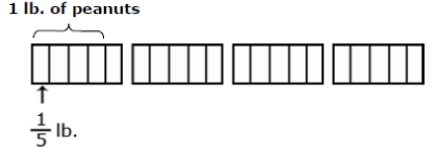General Information
Benchmark Instructional Guide
Connecting Benchmarks/Horizontal Alignment
Terms from the K-12 Glossary
- NA
Vertical Alignment
Previous Benchmarks
Next Benchmarks
Purpose and Instructional Strategies
The purpose of this benchmark is to connect division of fraction concepts to real-world scenarios (MTR.7.1). This work builds on the multiplication of fractions by whole numbers in grade 4 (MA.4.AR.1.3), and prepares them for grade 6 (MA.6.NSO.2.3) where they will solve real-world fraction problems using all four operations with fractions (MTR.7.1).- During instruction, it is important for students to have opportunities to extend their understanding of the meaning of fractions, how many unit fractions are in a whole, and their understanding of division of fractions as involving equal groups or shares and the number of objects in each.
- Students should use visual fraction models and reasoning to solve word problems involving division of fractions.
- For example, to assist students with solving the problem, “The elephant eats 4 lbs of peanuts a day. His trainer gives him of a pound at a time. How many times a day does the elephant eat peanuts?” use the following diagram to show how 4 ÷ can be visualized to assist students with solving.

- The expectation of this benchmark is not for students to use an algorithm (e.g., multiplicative inverse) to divide fractions.
- Instruction includes students using equivalent fractions to simplify answers; however, putting answers in simplest form is not a priority.
Common Misconceptions or Errors
- Students may believe that division always results in a smaller number, which is true when dividing a fraction by a whole number, but not when dividing a whole number by a fraction. Using models will help students develop the understanding needed for computation with fractions.
Strategies to Support Tiered Instruction
- Instruction includes opportunities to engage in teacher-directed practice using visual representations to solve real-world problems involving division of a unit fraction by a whole number or a whole number by a unit fraction. The teacher directs students on how to use models or equations based on real-world situations. Through questioning, the teacher guides students to explain what each fractional portion represents in the problems used during instruction and practice.
- For example, the teacher displays and reads aloud the following problem: “Julio has 6 packages of cookies. He is making gift bags for people at school. Each bag will contain of a package of cookies. How many gift bags can he make?” Using models, the teacher solves the problem with guided questioning having students explain how to use models to solve this question. The teacher guides students to create an equation to represent the problem. This is repeated with multiple real-world examples that involve division of a unit fraction by a whole number or a whole number by a unit fraction.

- Teacher provides opportunities to use hands-on models and manipulatives to solve real- world problems involving division of a unit fraction by a whole number or a whole number by a unit fraction. Students explain how each model represents the real-world situation. The teacher directs students how to use models or equations based on real- world examples and through questioning guide students to explain what each fractional portion represents in the problems used during instruction and practice.
- For example, the teacher displays and reads aloud the following problem: “Shelton made some lemonade. The pitcher of lemonade holds 8 cups. If each of the glasses that he uses can hold cup, how many servings of lemonade can he share?” Using fraction bars or fraction strips, the teacher models solving the problem with explicit instruction and guided questioning. Students explain how to use fraction bars or fraction strips as a model to solve this question and use an equation to represent the problem. This is repeated with multiple real-world problems that involve multiplication of a whole number by a fraction or a fraction by a whole number.

Instructional Tasks
Instructional Task 1 (MTR.6.1, MTR.7.1)
Sonya has gallon of chocolate chip ice cream. She wants to share her ice cream with 6 friends. How much ice cream will each friend get?
Instructional Items
Instructional Items 1
Betty has 12 sheets of tissue paper to add to her holiday gift bags. Each gift bag needs sheet of tissue paper. How many holiday gift bags can Betty fill?*The strategies, tasks and items included in the B1G-M are examples and should not be considered comprehensive.

 acre and needs to be divided equally among 3 sisters. Each sister will receive
acre and needs to be divided equally among 3 sisters. Each sister will receive  of an acre.
of an acre.  of a candy bar to her classmates at school. How many classmates will receive a piece of a candy bar?
of a candy bar to her classmates at school. How many classmates will receive a piece of a candy bar?